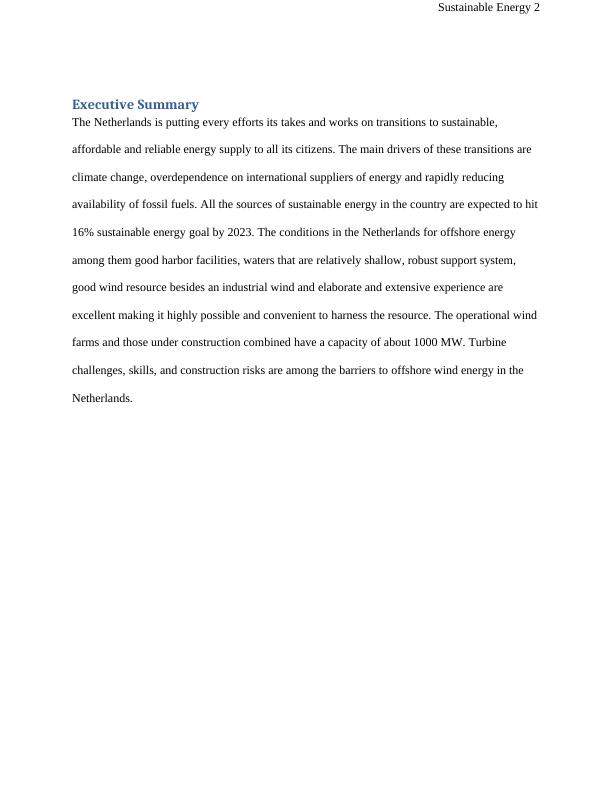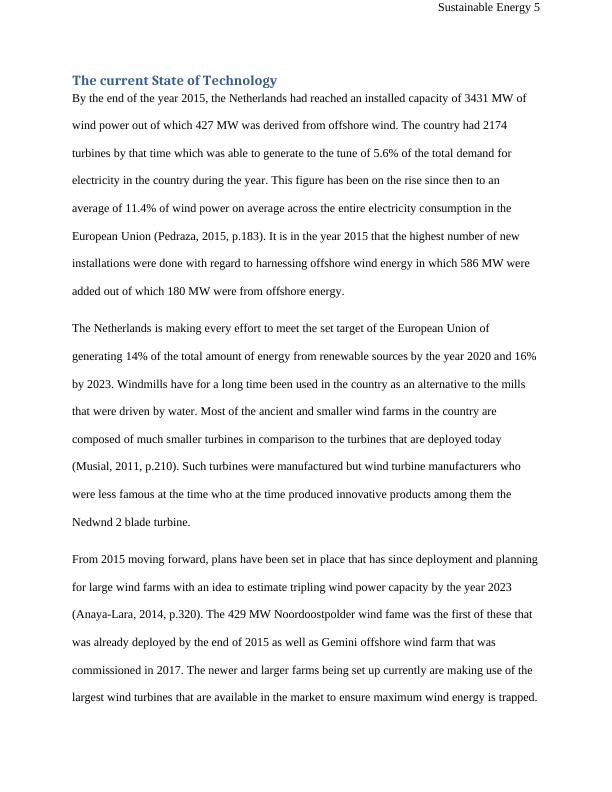Sustainable Energy (PDF)
Added on 2021-05-31
22 Pages6148 Words20 Views
Sustainable Energy 1SUSTAINABLE ENERGYBy NameCourseInstructorInstitutionLocationDate

Sustainable Energy 2Executive SummaryThe Netherlands is putting every efforts its takes and works on transitions to sustainable, affordable and reliable energy supply to all its citizens. The main drivers of these transitions are climate change, overdependence on international suppliers of energy and rapidly reducing availability of fossil fuels. All the sources of sustainable energy in the country are expected to hit16% sustainable energy goal by 2023. The conditions in the Netherlands for offshore energy among them good harbor facilities, waters that are relatively shallow, robust support system, good wind resource besides an industrial wind and elaborate and extensive experience are excellent making it highly possible and convenient to harness the resource. The operational windfarms and those under construction combined have a capacity of about 1000 MW. Turbine challenges, skills, and construction risks are among the barriers to offshore wind energy in the Netherlands.

Sustainable Energy 3ContentsExecutive Summary.....................................................................................................................................2Introduction.................................................................................................................................................4The current State of Technology.................................................................................................................5Offshore wind farms in the Netherlands.................................................................................................7The roadmap towards 4500 MW offshore wind power in the Netherlands............................................8The Offshore Wind Energy Law...............................................................................................................9Impacts on the energy systems.................................................................................................................12Technical developments in the future.......................................................................................................13Barriers and Opportunities to offshore wind power in the Netherlands...................................................15Turbine challenges.................................................................................................................................15Building Manpower...............................................................................................................................16Construction Risks.................................................................................................................................17Building Successful Offshore..................................................................................................................19Conclusion.................................................................................................................................................19References.................................................................................................................................................21

Sustainable Energy 4OFFSHORE WIND ENERGY IN NETHERLANDSIntroductionIn accordance with the international developments, the Netherlands experiences numerous challenges in her attempts to lower global emissions of greenhouse gases to the atmosphere. As per the international agreement on climate change, an agreement was reached for an achievementof a global balance between emissions of greenhouse gases and trapping and storage by the second half of the 21st century (Arent, 2017, p.172). Despite these numerous challenges, the Netherlands is putting every effort it takes and works on transitions to sustainable, affordable andreliable energy supply to all her citizens. The main drivers of the transition include climate change, overdependence on the international supplier of energy as well as the rapidly reducing availability of fossil fuels. As per the National Energy Agreement, a unanimous consensus was reached that each organization in the country including the Ministries, unions, NGOs, energy organizations and employer organizations hit a target of 16% sustainable energy by 2023. All the sources of sustainable energy in the country are expected to hit this goal and the wind energy sector both land-based and offshore are not left behind either (Ghosh, 2011, p.213). The conditions in the Netherlands for offshore energy are excellent making it highly possible and convenient to harness the resource. Among the conditions in the country include good harbor facilities, waters that are relatively shallow, robust support system, good wind resource besides an industrial wind and elaborate and extensive experience.

Sustainable Energy 5The current State of TechnologyBy the end of the year 2015, the Netherlands had reached an installed capacity of 3431 MW of wind power out of which 427 MW was derived from offshore wind. The country had 2174 turbines by that time which was able to generate to the tune of 5.6% of the total demand for electricity in the country during the year. This figure has been on the rise since then to an average of 11.4% of wind power on average across the entire electricity consumption in the European Union (Pedraza, 2015, p.183). It is in the year 2015 that the highest number of new installations were done with regard to harnessing offshore wind energy in which 586 MW were added out of which 180 MW were from offshore energy. The Netherlands is making every effort to meet the set target of the European Union of generating 14% of the total amount of energy from renewable sources by the year 2020 and 16% by 2023. Windmills have for a long time been used in the country as an alternative to the mills that were driven by water. Most of the ancient and smaller wind farms in the country are composed of much smaller turbines in comparison to the turbines that are deployed today (Musial, 2011, p.210). Such turbines were manufactured but wind turbine manufacturers who were less famous at the time who at the time produced innovative products among them the Nedwnd 2 blade turbine. From 2015 moving forward, plans have been set in place that has since deployment and planningfor large wind farms with an idea to estimate tripling wind power capacity by the year 2023 (Anaya-Lara, 2014, p.320). The 429 MW Noordoostpolder wind fame was the first of these that was already deployed by the end of 2015 as well as Gemini offshore wind farm that was commissioned in 2017. The newer and larger farms being set up currently are making use of the largest wind turbines that are available in the market to ensure maximum wind energy is trapped.

Sustainable Energy 6The Netherlands has also taken advantage of the good linkages she has with her neighbors to ensure a high rise in the production of intermittent power from wind energy through the use of high voltage cable which allows power to be exported or imported as needed. Among such linkages include the 1000 MW BritNed cable link which links to the United Kingdom, the 580 km NorNed submarine cable which is 700 MW and likes to Norway as well as the anticipated 2019 COBRA cable link that will link the Netherlands to Denmark and supply 700 MW of wind energy. The government of Netherlands has set a target of 4450 MW of offshore wind power by 2023 which if achieved will enable the country to realize the 14% target of renewable energy use fromthe total energy use by 2020 and 16% by 2023 (Beurskens, 2011, p.245). The country has set in place a new tendering system for offshore wind in which the deployment of the new wind farm isbased on the SER agreement. The SER agreement defines five years plans of tending 700 MW every year. Under this system, the government makes a choice on the locations and arranges tenders for projects of 350 MW while the project developers are then given an opportunity to offer bids for each of the farms. The government is also in charge of surveys of the sites so as to reduce the costs of multiple and unplanned surveys by the developers. The table below shows the offshore wind energy targets as defined in the 2015 SER agreementCall for tenderAdditional offshore wind power (MW)Becoming OperationalEarly 20167002019-2020Late 20167002020201770020212018700202220197002023Total 3, 500

End of preview
Want to access all the pages? Upload your documents or become a member.
